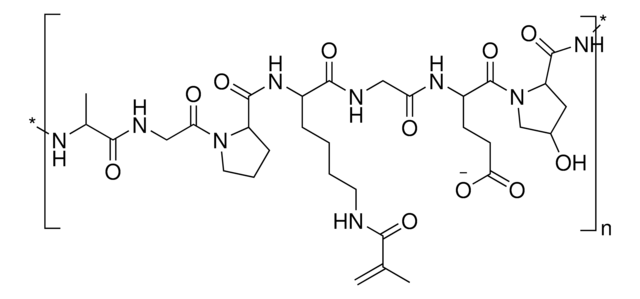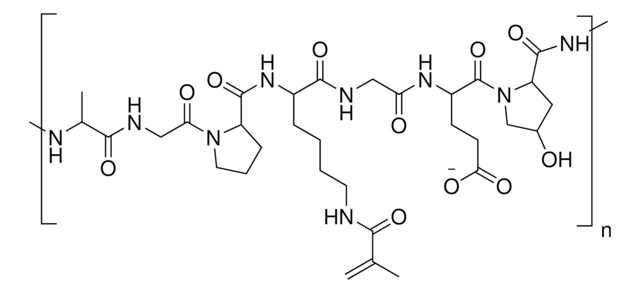938904
TissueFab® Discrete GelMA

300 bloom, 50% degree of substitution
Synonym(e):
GeIMA, Gelatin Methacrylate, Gelatin methacrylamide
About This Item
Empfohlene Produkte
Qualitätsniveau
Beschreibung
Application: 3D bioprinting, tissue engineering
Form
(powder or chunk(s) or fibers)
Farbe
, white to light brown
Lagertemp.
−20°C
Verwandte Kategorien
Allgemeine Beschreibung
Many GelMAs currently available have a high degree of variation and inconsistency. To address this, the TissueFab(R) Discrete GelMAs have been developed to achieve a specific degree of methacrylation with low batch to batch variability.
Anwendung
- Tissue engineering - including bone tissue, cartilage tissue, epidermal tissue, and cardiac tissue
- Regenerative medicine - including injectable tissue constructs and endothelial cell morphogenesis
- Drug and cell delivery - in the form of microspheres and hydrogels
- Surface coatings - of medical devices and implants in order to improve biocompatibility and release therapuetic cargos
Leistungsmerkmale und Vorteile
- Specific degree of methacrylation - a narrow peak of methacrylation allows for better reproducibility, low batch to batch variability, for improved consistency of gel properties and cell behavior.
- Biocompatibility - GelMA contains RGD sequences, found in collagen and other natural ECM proteins, which promote cell adhesion, proliferation, differentiation, and maturation of a variety of cell types.
- Biodegradability - GelMA contains matrix metalloproteinase (MMP) degradable sites that can be recognized and enzymatically degraded by cells. This allows the encapsulated cells to degrade and remodel the GelMA matrix, and repopulate with their own cells and tissues, a major goal for tissue engineering and regenerative medicine.
- Tunability - The TissueFab(R) Discrete GelMAs are available in a variety of degrees of substitution which ultimately impact the hydrogel stiffness and mechanical properties and can be used to recapitulate and accomodate different native tissues.
- Bioprintability - The TissueFab(R) Discrete GelMAs are widely used in the field of 3D bioprinting due to their unique gelation properties and the ability to print via extrusion and other methods to create intricate cell-encapsulated 3D structures with high cell viability.
Rechtliche Hinweise
Ähnliches Produkt
Lagerklassenschlüssel
11 - Combustible Solids
WGK
WGK 3
Flammpunkt (°F)
Not applicable
Flammpunkt (°C)
Not applicable
Analysenzertifikate (COA)
Suchen Sie nach Analysenzertifikate (COA), indem Sie die Lot-/Chargennummer des Produkts eingeben. Lot- und Chargennummern sind auf dem Produktetikett hinter den Wörtern ‘Lot’ oder ‘Batch’ (Lot oder Charge) zu finden.
Besitzen Sie dieses Produkt bereits?
In der Dokumentenbibliothek finden Sie die Dokumentation zu den Produkten, die Sie kürzlich erworben haben.
Unser Team von Wissenschaftlern verfügt über Erfahrung in allen Forschungsbereichen einschließlich Life Science, Materialwissenschaften, chemischer Synthese, Chromatographie, Analytik und vielen mehr..
Setzen Sie sich mit dem technischen Dienst in Verbindung.




